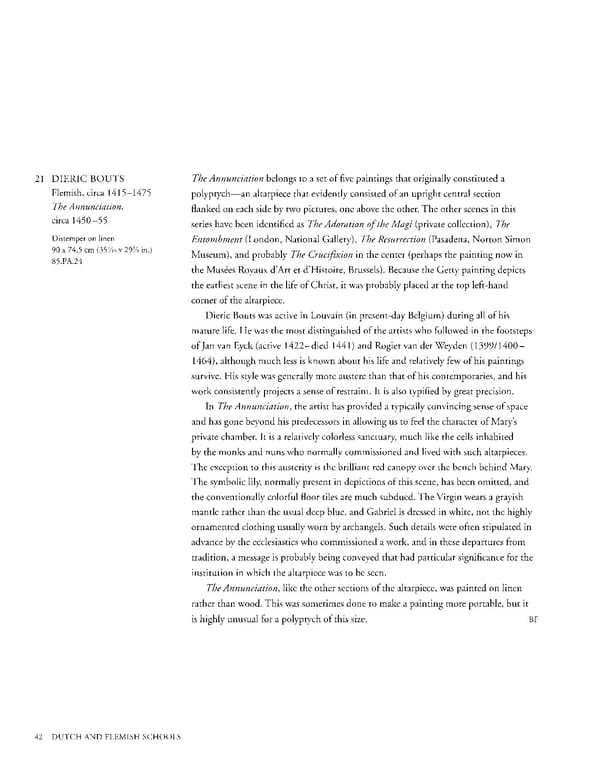21 DIERIC BOUTS The Annunciation belongs to a set of five paintings that originally constituted a Flemish, circa 14151475 polyptych—an altarpiece that evidently consisted of an upright central section The Annunciation, flanked on each side by two pictures, one above the other. The other scenes in this circa 145055 series have been identified as The Adoration of the Magi (private collection), The Distemper on linen Entombment (London, National Gallery), The Resurrection (Pasadena, Norton Simon 90 x 74.5 cm (35 7/16 x 29 in.) Museum), and probably The Crucifixion in the center (perhaps the painting now in 85.PA.24 the Musees Royaux d'Art et d'Histoire, Brussels). Because the Getty painting depicts the earliest scene in the life of Christ, it was probably placed at the top lefthand corner of the altarpiece. Dieric Bouts was active in Louvain (in presentday Belgium) during all of his mature life. He was the most distinguished of the artists who followed in the footsteps of Jan van Eyck (active 1422died 1441) and Rogier van der Weyden (1399/1400 1464), although much less is known about his life and relatively few of his paintings survive. His style was generally more austere than that of his contemporaries, and his work consistently projects a sense of restraint. It is also typified by great precision. In The Annunciation, the artist has provided a typically convincing sense of space and has gone beyond his predecessors in allowing us to feel the character of Mary's private chamber. It is a relatively colorless sanctuary, much like the cells inhabited by the monks and nuns who normally commissioned and lived with such altarpieces. The exception to this austerity is the brilliant red canopy over the bench behind Mary. The symbolic lily, normally present in depictions of this scene, has been omitted, and the conventionally colorful floor tiles are much subdued. The Virgin wears a grayish mantle rather than the usual deep blue, and Gabriel is dressed in white, not the highly ornamented clothing usually worn by archangels. Such details were often stipulated in advance by the ecclesiastics who commissioned a work, and in these departures from tradition, a message is probably being conveyed that had particular significance for the institution in which the altarpiece was to be seen. The Annunciation, like the other sections of the altarpiece, was painted on linen rather than wood. This was sometimes done to make a painting more portable, but it is highly unusual for a polyptych of this size. BF 42 DUTCH AND FLEMISH SCHOOLS
 Masterpieces of the Getty Museum: Paintings Page 42 Page 44
Masterpieces of the Getty Museum: Paintings Page 42 Page 44